1. Draw indifference curves that represent the following individuals' preferences for hamburgers and soft driaks with the number of sof drinks on the horizontal axis. Indicate the direction in which the individuals" satisfaction (or utiliny) is increasing. a. Jane loves hamburgers and is indifferent to sof drinks. b. Bob loves hamburgers and dislikes sof drinks. c. Joe has diminishing marginal utility for all goods and dislikes both hamburgen and sof drinks. d. Molly loves hamburgers and soft drinks, but insists on consuming exactly one soft drink for every hamburger that she cats. e. Alex always gets twice as much satisfaction from an extra hamburger as she does from an extra soft drink. 2. Andrew, a sports fan, derives utility from attending football and basketball games. The price of each football ticket is $5; the price of a basketball game is $10. Each football game takes three hours; cach basketball game takes two hours. a. Suppose that Andrew has $S0 per month to spend on game tickets, and that he has more than enough time to attend all the games be wants. Sketch Andrew's budget constraint. (Place the quantity of football games on the horizontal axis.) b. Suppose now that Andrew can only spend 18 hours per month at sporting events, but he has more than enough money to attend all the games that be wants. Sketch Andrew's new budget constraint. c. Now assume that Andrew has only $50 per month to spend and only 18 bours per month available. Sketeh the budget constraint, and explain why it can be chamcterized as having a kink. d. Suppose that Andrew's point of maximum utility occurs at the kink. What can you say about the value of the marginal rate of substitution in equilibrium? What is the MRS if the equilibrium is not at the kink? 3. Ben allocates his lunch budget between two goods, pizra and burgers. a. Illustrate Ben's optimal bundle of pizza and burgers on a graph with pizza on the horizontal axis. b. Suppose now that pizza is taxed, causing the price to increase by 20 percent. Illustrate how this changes the budget constraint and Ben's new optimal bundle. c. Suppose instead that piza is rationed at a quantity less than Ben's desired quantity. Illustrate Ben's new optimal bundle. What combination of pizra and burgers should he buy to maximize his utility now? 4. When the price of video game rentals is $4/game, Jon rents 10 games per week, and spends $160 on all other goods. The local video store then institutes a new pricing policy: Jon has to pay a weckly membership fee of 530 , but be can then rent games at a price of $1 each. a. Will Jon be able to buy an old bundle of goods ( 10 games and 160 of all other goods)? Draw both budget lines and both highest affordable indifference curves on a graph. Show the new and old equilibria. b. Does the new policy make Jon better off, worse off, or have no effect on him? Explain using the graph from question a. e. Would your answer change if games and all other goods are perfect complements? 5. The local swimming pool charges nonmembers $10 per visit. If you join the pool, you ean swim for $5 per visit, but you have to pay an annual fee of SF. Use an indifference curve diagram with the composite good on the vertical axis and swim visits on the horizontal axis to find the value of F (graphically) that would make it just worthwhile for you to join the pool. Suppose that the pool charged you exactly that value. Would you swim more or less than you did before joining? Explain







